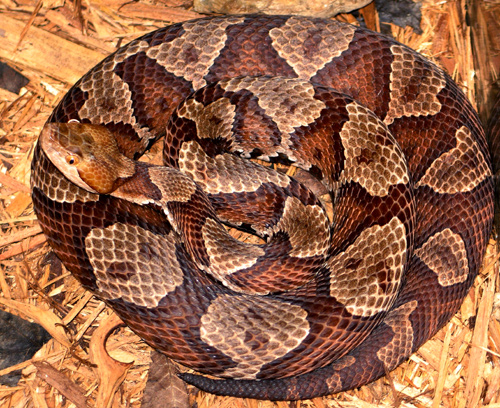The northern copperhead is a pit viper, so named because of two heat-sensing pits located between the eyes and nostrils. Copperheads are venomous. They are stocky snakes with copper-colored, brown or reddish-brown hour-glass-shaped bands along their body against a lighter background color. Their bellies are pinkish and may have dark markings. Their heads are much wider than their necks and have a triangular shape. They have yellow or coppery eyes. Unlike the eyes of the non-venomous snakes in Connecticut, a copperhead's eyes have vertical pupils. Copperheads also have 2 openings on each side of their head in contrast to the 1 opening present in Connecticut's non-venomous snakes. Northern copperheads can be 24 to 37 inches long.
There are several copperhead subspecies that range through the eastern states of the US; the range is generally from southwestern Massachusettes west to extreme southeastern Nebraska and south to the Florida panhandle and south-central Texas. Northern copperheads are found in the southern, central and north central portions of Connecticut. They are not found in the northeastern and northwesterns corners of the state.
Copperhead habitat includes open woods, the edges of wetlands and meadows, rocky hills, talus slopes and rock ridges.
Mating season occurs primarily in May in New England. Some snakes may mate in the fall. A male will track the scent of females with his tongue. When a female is located, he will approach and try to rub her with his chin, follow if she moves away, and continue to try to place his head on her and align his body with hers. An agreeable female will wave or whip her tail back and forth or vibrate it. If she is ready to mate she will lift the rear part of her body a little bit so the male can place his tail underneath hers and mating can occur. Mating can last 3 to 8 hours. Males will try to mate with more than one female.
The female will bear live young after a 3-9 month gestation period, usually in September. A snake that has mated in the fall will likely not give birth until the following spring. 3-10 babies are born and are not cared for by their mother. They are about 7 to 9 inches long and have fangs and venom from the start.
Copperheads are more likely to be out basking during the day in spring and fall. Snakes cannot regulate their body temperature internally and must warm themselves in the sun. Over the warmer months they are more nocturnal. They hibernate in the winter from about late September or October to about April. Dens in rock crevices or old burrows are generally used, and these snakes often den communally. They can share winter dens with other copperheads or with other snake species. They will often use the same den for years.
Northern copperheads eat insects, mice, other rodents, small birds and frogs. They hunt by lying motionless in ambush for their prey. They locate prey by sight, smell and can sense body heat with their sensory pits. When prey animals come near, the snake strikes.
Northern copperheads have fangs for delivering venom. These are hunting tools and their design is fascinating. The two fangs are attached to the upper jaw and fold back aginst the roof of the mouth in sheaths. Each fang has a duct that is connected to one of the snake's venom glands in the gum. When the snake strikes prey, the fangs move forward and out and puncture the animal. Muscles force venom out of the gland, through the fang and into the prey. Periodically fangs are shed and replaced with new ones that have developed in the gum behind the preceeding fang.
The venom kills the small animals these snakes eat very quickly. After striking, the snake tracks the animal by heat and scent until it has been overcome by the poison and the snake can swallow their meal whole.
It is worth noting that, although copperheads will bite in self-defense if surprised, threatened or handled, they are NOT out to get humans. We are much too large for their tastes. They will try to avoid contact, and wish to be left alone. A copperhead does not deliver enough poison to kill the average, healthy, adult human being. That being said, a bite that delivers venom (sources say around 25% percentage of defensive bites are "dry" meaning no venom is delivered) can be extremely painful, cause tissue injury, and make a person quite sick. Bites are dangerous.
To avoid trouble, don't harrass or approach snakes, don't try to handle one, watch where you step, and if you see a copperhead, move away slowly. They really don't want to interact with you.
The current recommendations for snakebite first aid from the Center for Disease Control are as follows: First, after moving away from the snake, get medical help for the victim as soon as possible. This is something for which 911 should be called. Keep the bitten person calm and quiet. Have them lay down or sit down with the bitten area lower than the heart if possible. Wash the bite with soap and water and cover with a clean dressing. Do not pursue the snake and try to catch it. Do not apply a tourniquet or cut the puncture wounds with a knife. Do not attempt to suck out venom. Do not immerse the wound in water or use ice. Do not let the victim drink alcohol or caffeine.
The non-venomous eastern milk snake, dekay's brownsake and eastern hog-nosed snake are often mistakenly thought to be copperheads.
